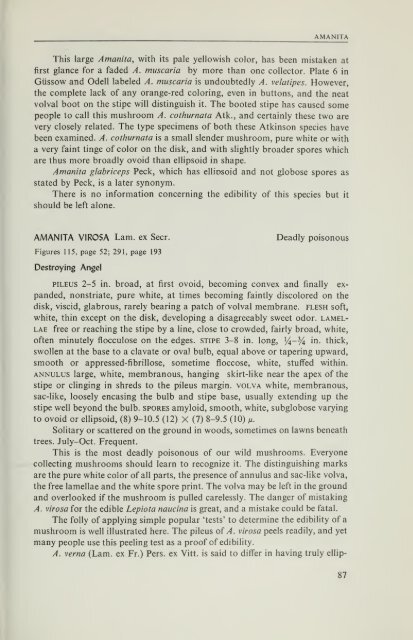You also want an ePaper? Increase the reach of your titles
YUMPU automatically turns print PDFs into web optimized ePapers that Google loves.
AMANITA<br />
This large Amanita, with its pale yellowish color, has been mistaken at<br />
first glance for a faded A. muscaria by more than one collector. Plate 6 in<br />
Giissow and Odell labeled A. muscaria is undoubtedly A. velatipes. However,<br />
the complete lack of any orange-red coloring, even in buttons, and the neat<br />
volval boot on the stipe will distinguish it. The booted stipe has caused some<br />
people to call this mushroom A. cothurnata Atk., and certainly these two are<br />
very closely related. The type specimens of both these Atkinson species have<br />
been examined. A. cothurnata is a small slender mushroom, pure white or with<br />
a very faint tinge of color on the disk, and with shghtly broader spores which<br />
are thus more broadly ovoid than ellipsoid in shape.<br />
Amanita glabriceps Peck, which has elliosoid and not globose spores as<br />
stated by Peck, is a later synonym.<br />
There is no information concerning the edibihty of this species but it<br />
should be left alone.<br />
AMANITA VI ROSA Lam. ex Seer. Deadly poisonous<br />
Figures 115, page 52; 291, page 193<br />
Destroying Angel<br />
PILEUS 2-5 in. broad, at first ovoid, becoming convex and finally ex-<br />
panded, nonstriate, pure white, at times becoming faintly discolored on the<br />
disk, viscid, glabrous, rarely bearing a patch of volval membrane, flesh soft,<br />
white, thin except on the disk, developing a disagreeably sweet odor, lamel-<br />
lae free or reaching the stipe by a line, close to crowded, fairly broad, white,<br />
often minutely flocculose on the edges, stipe 3-8 in. long, |4-% ii^- thick,<br />
swollen at the base to a clavate or oval bulb, equal above or tapering upward,<br />
smooth or appressed-fibrillose, sometime floccose, white, stuffed within.<br />
ANNULUS large, white, membranous, hanging skirt-like near the apex of the<br />
stipe or clinging in shreds to the pileus margin, volva white, membranous,<br />
sac-like, loosely encasing the bulb and stipe base, usually extending up the<br />
stipe well beyond the bulb, spores amyloid, smooth, white, subglobose varying<br />
to ovoid or elHpsoid, (8) 9-10.5 (12) X (7) 8-9.5 (10) /z.<br />
Solitary or scattered on the ground in woods, sometimes on lawns beneath<br />
trees. July-Oct. Frequent.<br />
This is the most deadly poisonous of our wild mushrooms. Everyone<br />
collecting mushrooms should learn to recognize it. The distinguishing marks<br />
are the pure white color of all parts, the presence of annulus and sac-like volva,<br />
the free lamellae and the white spore print. The volva may be left in the ground<br />
and overlooked if the mushroom is pulled carelessly. The danger of mistaking<br />
A. virosa for the edible Lepiota naucina is great, and a mistake could be fatal.<br />
The folly of applying simple popular 'tests' to determine the edibility of a<br />
mushroom is well illustrated here. The pileus o^ A. virosa peels readily, and yet<br />
many people use this peehng test as a proof of edibility.<br />
A. verna (Lam. ex Fr.) Pers. ex Vitt. is said to differ in having truly ellip-<br />
87

















